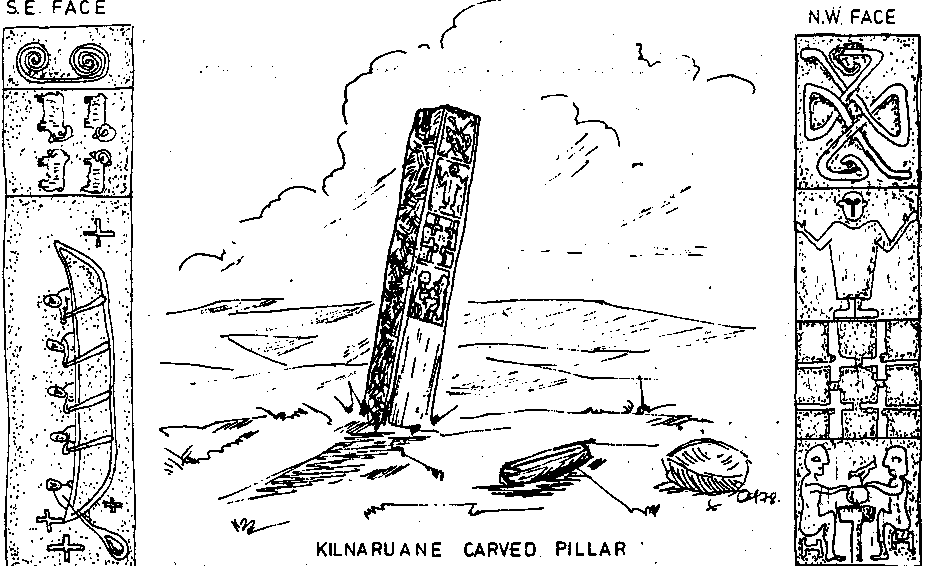
MURPHYS BANTRY MUSSEL FAIR MAY 4th to MAY 7th 2000
OUR HERITAGE
The name Bantry comes from the Gaelic Beanntrai, which means the people of Beannt, who was a Gaelic Chieftain. Situated at the mouth of one of the deepest natural harbors in the world, Bantry town overlooks a beautiful bay that resulted from placation during the ice age.
ARCHAEOLOGICAL HERITAGE

Bantry is at the heart of a very ancient region, which carries one of the greatest concentrations of Megalithic and Neolithic monuments in Europe, predating the pyramids of Egypt. The Kilnaruane Stone pictured above dates back to the early Christian period and occupies a commanding site overlooking the town.
Relics of the period between the 15th century and 17th century that include ruins of castles and Mass rocks are numerous in the area. In 1796 a huge French fleet sailed into Bantry Bay in an attempt to liberate Ireland.
Sites of Archaeological Interest
Ancient Burial Places:
Throughout the Neolithic and Early Bronze Age (c.3500 - c.1500 BC) collective burial in stone tombs was a common practice of among rural communities all over Western Europe. These tombs were burial chambers with walls of upright stones, roofed over by flat stones. There were four main types of these megalithic tombs, called court-tombs, portal-tombs, passage tombs and wedge-tombs. In the south-west of Ireland, the wedge-tombs are the most encountered variety. They generally face in a south-westerly direction. An example of one of these can be seen at Crossoge.
Boulder-burials consist of large boulders resting on three or more low stones. They usually occur singly or in small groups and it is thought that they can be placed in the Bronze Age. Examples can be found at Ballycomane, Breenymore and Cappanaboul.
Stone Circles and Standing Stones:
Stone circles comprise a ring of free-standing stones, uneven in number and arranged so that one stone, called the axial-stone, is set directly opposite two stones. This axial-stone is usually found in the south-west part of the circle. Stone Circles can be divided into two types, five-stone and multiple-stone circles. They are not generally regarded as burial places even though cremated remains have been discovered at some of them. They appear to have been ritual sites where ceremonies took place, possibly associated with sun-worship as the main axis of many of them appears to be orientated to mark the direction of the sun at a solstice or equinox. Multiple-stone circles can be seen at Cappanaboul, Breenymore and Maughanaclea, while there are examples of five-stone circles at Kealkill, and Mill Little.
Standing stones can be found as stone rows or stone pairs. Stone rows consist of thre or more standing stones, usually aligned along a north-east south-west axis. The stones are generally graded in height with the tallest at the south-western end. They are thought to date to the Bronze Age and like the stone circles probably were linked with some sort of ceremonial or ritual. Examples can be found at Ardrah, Kielnascarta and Maulinward.
Stone pairs can be regarded as fulfilling the same function as stone rows except this time the stones occur in pairs. These can be seen at Baurgorm, Ballycomane and Cappaboy Beg.
Fulachta Fiadh :
This term comes from two Gaelic words the first of which means a ‘cooking pit’ and the second may be connected either with hunting or else with a roving band of warriors. They are ancient cooking places and survive as horseshoe shaped mounds of earth containing burnt material. The cooking took place in a rectangular shaped pit or trough which was filled with water. The water was then heated by rolling hot stones into it from a nearby fire. Examples can be found at Carriganass and Dromnea.
|
|
||
Any comments or queries to our Email
musselfair@eircom.net